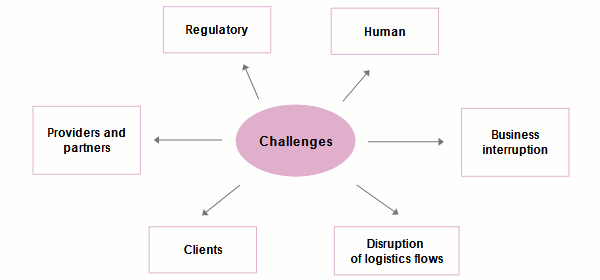Pandemic threat
 D’autres virus que la grippe ont, à une moindre échelle, menacé les hommes. En 2013, Ebola a fait des ravages en Afrique de l’Ouest et il a fallu plusieurs années et beaucoup d’efforts pour éradiquer le phénomène en 2018. Apart from the flu, other viruses of a lower scale, have threatened mankind. In 2013, Ebola had devastated West Africa for years before it was eradicated in 2018 after long years of strenuous efforts.
D’autres virus que la grippe ont, à une moindre échelle, menacé les hommes. En 2013, Ebola a fait des ravages en Afrique de l’Ouest et il a fallu plusieurs années et beaucoup d’efforts pour éradiquer le phénomène en 2018. Apart from the flu, other viruses of a lower scale, have threatened mankind. In 2013, Ebola had devastated West Africa for years before it was eradicated in 2018 after long years of strenuous efforts.
Some personalities took it upon themselves to highlight the threats every now and then. Early 2017, Bill Gates attempted to warn authorities about what he considered back then as imminent threat for the 10 to 15 years to come. The international community did not listen to these calls, and despite the recurrent episodes, the pandemic threat remains underestimated.
Politicians are rather keen on tackling most visible threats such as terrorism, global warming than on population growth and flow of persons.
Focused on economic growth, the financial crisis and digitization, insurers and reinsurers have hardly done anything against pandemics. Consequently, the health crisis triggered by coronavirus is now upsetting all priorities. It is now an unexpected crash test for the insurance industry.
Definitions
Epidemic
The term epidemic refers to the abrupt increase in the incidence of a disease in a specific region, featuring a significant risk but of localized nature, which makes it controllable from health, financial and insurance standpoints.
Pandemic
Pandemic is referred to in the event of an epidemic spread to several countries, continents and even the whole world. A pandemic can quickly become an unavoidable risk, which we can no longer contain or stop.
In addition, the pandemic, according to the WHO definition, must be caused by a new pathogen or one that has not appeared for a long time.
Endemic
The term endemic is used in case a disease lingers on in a limited geographical area. This is accounted for by the fact that it has always been there, or that it has raged there periodically at same periods of time. The presence of an endemic is known and reported without progressing or spreading. Malaria and yellow fever, which are endemic plagues, are uncontrolled in well-known areas.
Beyond the geographic factor, contagiousness is an extremely important aspect of the pandemic. Contagion speed depends largely on behavioral factors.
Pandemics classification
The American Institute of Medicine classifies pandemics into three categories:
- Infections passed on from animals to humans and that transform into epidemics,
- Infections resulting from mutated pathogenic factors and against which there is no immune protection for, example the flu,
- Infections that have invaded new regions of the globe.
Read also: 20th and 21st century's major pandemics
Pandemics enabling factors
Influenza pandemics, in particular, are rare events to date, characterized by serious effects both on human life and on their health. Their magnitude is sometimes such that millions of people are infected.
Seriously-ill people may experience episodes of disability requiring hospitalization. The number of deaths can reach several million individuals.
The treatments, sometimes heavy, are not free from significant side effects such as the weakening of the immune system, or effects on the heart, as is the case for care based on chloroquine, molecule supposed to improve the state of patients with coronavirus.
For a virus to spread unpredictably and quickly, it must originate from:
- A disease which already exists and which has mutated,
- An unknown source. In this case, there is no predisposition to immunity from the pathology in effect. It is therefore all of the individuals who are potentially contaminated.
Population movement
The spread of pandemics depends largely on the size of the population and its increase. During the 20th century, the planet's population quadrupled from one and a half billion to six billion. In the 21st century, it has reached 7 billion people.
In the meantime, large cities and megalopolises have developed, which constitutes a particularly fertile ground for contagious diseases.
Booming air traffic greatly facilitates the spread of infectious diseases, taking a few hours to infect individuals located thousands of kilometers away, whereas it took six months to bring the plague from the shores of the Black Sea to the south of France.
Spread by mosquitos
Mosquitoes are vectors of many diseases: malaria, chikungunia, Zika virus or yellow fever are a few examples
Food exports
Food, plants and meats in particular are sources of spread of viruses and bacteria. This was the case with the bacterium Escherichia coli in 2011. Carried by a seed imported from Egypt, this bacterium was introduced in Europe where it affected several hundred people who developed renal failures.
The pandemic, a threat to the economy
The threat posed by the pandemic to men has a direct impact on the companies where they work. It can paralyze an economy or the whole planet as it is currently the case with the new coronavirus.
The challenges are therefore numerous, especially since the risk is largely underestimated and the crisis management processes are almost non-existent:

Faced with an event of this magnitude, companies are required to:
- Maintain the protection of its personnel and assets,
- Maintain customer satisfaction,
- Maintain its reputation,
- Mitigate the financial and even legal consequences.
In order to face the pandemic, preserve the health of the employees and maintain a minimum of benefits, each company is required to devise a crisis management plan designed to ensure rapid restart of the activity and gain of competitive advantage in addition to reducing the costs caused by the crisis:
| Needs analysis and stakes | Analysis of response measures | |
|---|---|---|
| 1- Absenteeism | 5- Prevention and response measures | |
| 2- Interruption of key activities/processes | 6- Business continuity plan | |
| 3- Disruption of the distribution chain |  | 7- Watch and alert system |
| 4- Obligations towards customers and partners | 8- Crisis organisation | |
| 9- Internal and external communication | ||
| 10- External expertise |